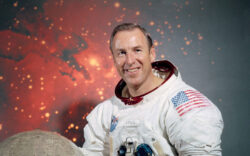There was no peace on Earth, but there was good will around the moon during the Christmas season of 1968. The year had been marked by a bloody war in Vietnam while riots raged on the streets of America, and the nation was shocked by the assassinations of the Rev. Martin Luther King Jr. and Sen. Robert Kennedy. As this country simmered, American astronauts Frank Borman, Jim Lovell and Bill Anders sailed serenely through space aboard their Apollo 8 spaceship on the first human voyage to the moon.
Borman, the commander of the historic Apollo 8 mission, died at age 95 on Nov. 7. The old astronaut’s two crewmates still survive. Lovell is 95, and Anders is 90. The three men were young when they set off to the moon during Christmas of 1968. They saw sights never before seen by human eyes, like the far side of the moon, and they brought back photos of a faraway Earth that Anders aptly called “a fragile Christmas tree ball which we should handle with considerable care.”
The daring lunar mission 55 years ago captured the imagination of the world. When the first humans gazed up at the moon many millennia ago, they must have felt a sense of wonder and mystery that later inspired lovers, poets, songwriters and scientists through thousands of years of time. French writer Jules Verne brought the dream of a lunar journey to millions of readers with his 1865 novel, From the Earth to the Moon, and its 1869 sequel, Around the Moon. In the postwar 20th century, long before the Apollo moon flights in real life, the moon was a setting for science fiction stories by such writers as Arthur C. Clarke, Ray Bradbury and Robert Heinlein. Moviegoers of 1950 saw Hollywood’s Technicolor treatment of a lunar landing in the film Destination Moon, an outer space “buddy movie” that was hailed for its special effects.
Apollo 8 orbited the moon during the Christmas season, and the astronauts aboard read verses from the biblical book of Genesis during a TV broadcast from their spacecraft as they soared over the crater-strewn surface of the moon. Though the holiday and the verses were Christian in nature, the uplifting achievement of the Apollo 8 mission was applauded by millions of Earth’s citizens of every religion or no religion at all. A photo that astronaut Anders took of a rising Earth in the blackness of space above the lunar landscape became a 20th century icon that inspired the environmental movement, causing Anders to reflect that in going to the moon, humanity had discovered Earth.

Though Apollo 8 was not intended to land on the moon, its flight to lunar orbit and its return to Earth was an unprecedented and memorable event that brought a needed boost to a beleaguered planet. The trip to the moon left impressions with the astronauts that resonate today. Anders said, “We’re living on a tiny little dust mote in left field of a rather insignificant galaxy, and basically this is it for humans. It strikes me that it’s a shame that we’re squabbling over oil and borders.”
Lovell recalled that his lunar journey showed him “how insignificant we are, and how fortunate we are to have a body [Earth] that will allow us to enjoy the sky and the trees and the water. It’s something that many people take for granted… but they don’t realize what they have—and I didn’t until I left it.”
Mission commander Borman was a serious military man who viewed Earth from the moon with both wonder and worry. “Raging nationalistic interests, famines, wars and pestilence don’t show up from that distance,” he said. “When you’re finally up on the moon looking back at Earth… you’re going to get a concept that maybe this is really one world, and why the hell can’t we learn to live together like decent people?”
The flight of Apollo 8 was a Christmas gift to Planet Earth after a year of global terror and tumult. It may have been summed up best by a telegram sent to Borman by an unknown American: “To the crew of Apollo 8. Thank you. You saved 1968.”
Like what you just read? Support Flagpole by making a donation today. Every dollar you give helps fund our ongoing mission to provide Athens with quality, independent journalism.










